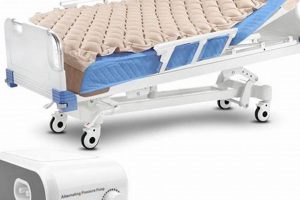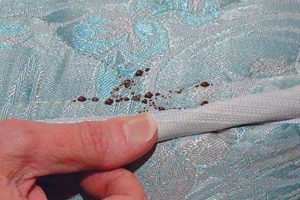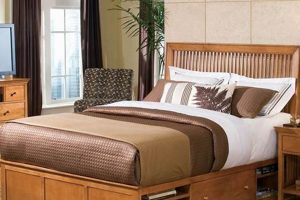These specialized encasements are designed to fully enclose a mattress, preventing bed bugs from entering or escaping. Constructed from tightly woven fabric, often with sealed zippers, they create a barrier that is impenetrable to these pests. For example, placing one on a newly purchased mattress can proactively shield it from infestation.
Their significance lies in their ability to protect individuals from bites, reduce allergic reactions caused by bed bug detritus, and minimize the need for costly and potentially harmful chemical treatments. Historically, they have been used as a preventative measure in areas prone to bed bug outbreaks and continue to be recommended by pest control professionals.
The subsequent sections will delve into the specific features to look for when selecting this type of product, the proper installation techniques, and the ongoing maintenance required to ensure its effectiveness.
Guidance on Implementing Bed Bug Mattress Encasements
The following outlines crucial considerations for selecting, installing, and maintaining mattress encasements to effectively manage potential or existing bed bug infestations.
Tip 1: Prioritize Quality Materials: Encasements should be crafted from tightly woven fabric with a pore size small enough to prevent bed bugs and their eggs from passing through. Examine product specifications carefully.
Tip 2: Ensure Zipper Security: A robust, sealed zipper is critical. Bed bugs can exploit even the smallest openings. Look for zippers with a locking mechanism or a fabric flap that completely covers the zipper closure.
Tip 3: Verify Encasement Fit: Precise sizing is essential. The encasement must fit snugly to the mattress, without gaps or excess material that could harbor pests. Accurately measure the mattress’s dimensions before purchasing.
Tip 4: Implement Proper Installation: Thoroughly inspect the mattress for any signs of bed bugs before encasing it. Carefully install the encasement, ensuring all seams and zippers are fully closed and secured.
Tip 5: Conduct Regular Inspections: Periodically examine the encasement for tears, punctures, or zipper malfunctions. Promptly repair or replace compromised encasements to maintain their protective barrier.
Tip 6: Maintain a Clean Environment: While the encasement protects the mattress, it is crucial to maintain a clean bedroom environment. Regularly vacuum the surrounding area, including the floor, baseboards, and any furniture.
Tip 7: Consider Professional Assistance: In cases of severe infestation, consult with a qualified pest control professional. Encasements are a valuable tool, but may need to be integrated into a comprehensive treatment plan.
Adhering to these guidelines maximizes the effectiveness of mattress encasements in preventing or controlling bed bug infestations, contributing to a healthier and more comfortable sleep environment.
The subsequent sections will provide further details about addressing potential infestations and complementary strategies.
1. Impermeable Barrier
The function of a mattress encasement is directly dependent on its ability to act as an impermeable barrier against bed bugs. The fabric must prevent the passage of bed bugs, in all life stages including eggs, into or out of the mattress. This is a cause-and-effect relationship: if the barrier is compromised, bed bugs can establish themselves within the mattress, negating the product’s purpose. The impermeability stems from both the tight weave of the fabric and the secure closure mechanism, typically a specialized zipper.
The selection of appropriate materials is critical for achieving this level of protection. For example, tightly woven polyester or polyethylene fabrics are frequently employed due to their inherent resistance to penetration. Conversely, loosely woven materials or those with defects render the encasement ineffective. The practical significance of this understanding lies in enabling informed consumer choices and promoting the adoption of products that genuinely contribute to bed bug control.
In summary, the impermeable barrier is the defining characteristic of a functional mattress encasement. Challenges in maintaining this barrier arise from fabric degradation over time, improper installation, or the use of substandard materials. A comprehensive understanding of this connection ensures appropriate selection and utilization of mattress encasements for bed bug management.
2. Zipper Integrity
Zipper integrity represents a critical component of any effective mattress encasement. The purpose of the encasement is defeated if bed bugs can penetrate it; the zipper constitutes a potential breach point. A compromised zipper, characterized by gaps, separations, or a lack of a secure locking mechanism, allows bed bugs to bypass the protective barrier. A real-world example is evident in situations where an encasement with a faulty zipper fails to prevent an infestation, resulting in continued biting and the need for more aggressive pest control measures. Therefore, zipper quality and functionality are directly linked to the overall efficacy of the encasement.
Consider the practical application: professional pest control companies routinely emphasize the importance of a sealed zipper when recommending encasements. This is not merely a superficial detail; it reflects a fundamental understanding of bed bug behavior. These pests are adept at exploiting even the smallest openings. Zipper designs incorporating features like fabric flaps covering the zipper teeth and secure locking sliders are specifically engineered to mitigate this risk. Therefore, examining the zipper mechanism and its ability to create an airtight seal is essential during product selection.
In summary, zipper integrity is non-negotiable for a mattress encasement to perform its intended function. Challenges arise from wear and tear, manufacturing defects, or improper use. The connection between zipper integrity and the overall effectiveness of the encasement is direct and significant. A well-designed and robust zipper contributes substantially to bed bug prevention, while a faulty one renders the entire encasement largely ineffective. Consequently, thorough inspection and mindful usage are necessary to maintain the integrity of this critical component.
3. Proper Fit
The effectiveness of a mattress encasement is inextricably linked to its proper fit. The purpose of this protective barrier is to isolate the mattress, preventing bed bugs from entering or escaping. A poorly fitted encasement, whether too loose or too small, undermines this function. If the encasement is too large,
excess material can create folds and crevices that provide harborage for bed bugs, effectively creating a protected environment within the intended protective layer. Conversely, an encasement that is too small may stretch or tear, compromising the integrity of the fabric and allowing entry. Therefore, the correct dimensions are paramount to achieving the desired outcome: a bug-proof barrier.
Consider the practical scenario of a hotel implementing encasements as part of its pest control strategy. If the encasements are not sized correctly for each mattress, the effort is largely wasted. Inconsistent sizing introduces vulnerabilities, leading to continued infestations and potential reputational damage. Real-world observations consistently show a direct correlation between poorly fitted encasements and ongoing bed bug problems. Pest control professionals routinely emphasize the importance of accurate measurements and selecting encasements that precisely match the mattress dimensions. This precision minimizes the risk of creating harborage areas or compromising the fabric’s integrity.
In summary, a proper fit is not merely a matter of convenience; it is an essential attribute of a functional mattress encasement. Challenges arise from inaccurate measurements, variations in mattress sizes, and the availability of appropriately sized encasements. The connection between proper fit and the overall efficacy of the encasement is undeniable. Ensuring the encasement fits snugly and securely contributes significantly to bed bug prevention and control, while a poorly fitted one negates many of the intended benefits. Accurate measurements and diligent installation are, therefore, critical to maximizing the protective capabilities of mattress encasements.
4. Durable Material
The long-term effectiveness of a mattress encasement hinges on the durability of its constituent materials. The fundamental purpose of the productto isolate the mattress from bed bugsis directly threatened if the material degrades, tears, or punctures. Durable materials provide a consistent, unbroken barrier, preventing both ingress and egress. The practical consequences of using substandard materials are evident in premature failure of the encasement, leading to renewed infestations and the need for costly replacements. Therefore, the selection of robust materials is not merely a matter of cost-effectiveness; it is a prerequisite for sustained bed bug control.
Consider the scenario of a multi-unit apartment building employing encasements across all units. If the encasements are made from flimsy materials, they are likely to be damaged during routine mattress handling, cleaning, or moving. This necessitates frequent replacements, increasing costs and potentially creating gaps in the building-wide pest control strategy. Real-world case studies demonstrate that encasements made from reinforced, tightly woven fabrics exhibit significantly longer lifespans and provide more reliable protection. The choice of material directly impacts the encasement’s ability to withstand everyday wear and tear, resist punctures from sharp objects, and maintain its barrier properties over time.
In summary, the durability of the material is a critical determinant of a mattress encasement’s overall value and effectiveness. Challenges in maintaining durability include exposure to harsh cleaning agents, physical stress, and variations in manufacturing quality. The connection between durable material and the long-term performance of the encasement is undeniable. Choosing encasements constructed from resilient, high-quality fabrics is essential for ensuring sustained protection against bed bugs and minimizing the need for frequent replacements, contributing to a more cost-effective and reliable pest management solution.
5. Certified Protection
The concept of “Certified Protection,” when applied to a mattress encasement, signifies that the product has undergone independent testing and verification to meet specific performance standards related to bed bug resistance. Cause-and-effect is evident: certified products have demonstrably prevented bed bug penetration in controlled laboratory environments, while uncertified products may fail under similar conditions. “Certified Protection” is not merely a marketing term; it represents a quantifiable measure of the product’s effectiveness and reliability. Real-life examples can be observed in independent reviews comparing certified and uncertified encasements, often revealing significant differences in their ability to withstand bed bug infestations. The practical significance of this understanding lies in empowering consumers to make informed decisions based on objective data rather than unsubstantiated claims.
The importance of certification extends beyond individual consumer protection; it also plays a crucial role in facilitating trust within the pest control industry. Professional pest management companies often rely on certified encasements as part of integrated pest management strategies, confident that these products will perform as expected. Certifications, such as those provided by entomological laboratories, often specify the minimum pore size of the fabric and the integrity of the zipper system, ensuring that bed bugs of all life stages cannot penetrate the encasement. Practical applications include widespread use in hotels, hospitals, and apartment complexes where bed bug infestations can have significant economic and public health consequences.
In summary, “Certified Protection” is a critical factor to consider when selecting a mattress encasement. Challenges in the certification process include maintaining consistency across different testing facilities and ensuring that the certification accurately reflects real-world performance. The connection between “Certified Protection” and the overall effectiveness of a mattress encasement is direct and substantial. By prioritizing certified products, consumers and pest management professionals can significantly increase the likelihood of successfully preventing and controlling bed bug infestations, leading to improved sleep quality and reduced exposure to these pests.
Frequently Asked Questions
This section addresses common inquiries regarding bed bug mattress encasements, providing concise answers to assist in informed decision-making.
Question 1: Are all mattress encasements equally effective against bed bugs?
No. Efficacy varies significantly based on material, construction, and zipper quality. Certified encasements, rigorously tested against bed bug penetration, offer a higher level of assurance.
Question 2: Can a bed bug mattress bag eliminate an existing bed bug infestation within a mattress?
While the encasement can trap existing bed bugs within the mattress, it will not eliminate them. Bed bugs can survive for extended periods without feeding. Complementary pest control measures are typically required.
Question 3: Is professional installation of a bed bug mattress bag necessary?
Professional installation is not typically required, but careful adherence to the manufacturer’s instructions is essential. Ensuring a snug fit and completely sealed zipper closure is critical for effectiveness.
Question 4: How often should a bed bug mattress bag be inspected for damage?
Regular inspections, ideally monthly, are recommended to identif
y any tears, punctures, or zipper malfunctions. Prompt repair or replacement is crucial to maintain the protective barrier.
Question 5: Can a bed bug mattress bag be washed?
Washing is generally not recommended, as it can compromise the integrity of the fabric and zipper. Spot cleaning with a damp cloth is usually sufficient. Always consult the manufacturer’s care instructions.
Question 6: What distinguishes a bed bug mattress bag from a standard mattress protector?
A bed bug mattress bag is specifically designed with a tightly woven fabric and sealed zipper to prevent bed bugs from entering or escaping. Standard mattress protectors typically lack these features and offer limited protection against bed bugs.
In summary, selecting a certified, well-fitted, and durable encasement, coupled with diligent inspection and maintenance, is paramount for effective bed bug management.
The subsequent section will discuss preventative measures beyond encasements to minimize the risk of infestation.
Conclusion
This article has explored the essential features and applications of the bed bug mattress bag as a tool in bed bug management. Key points include the importance of material quality, zipper integrity, proper fit, durability, and the value of certified protection. The encasement functions as a physical barrier, preventing bed bugs from infesting mattresses and hindering existing infestations. However, it is emphasized that the mattress bag is most effective when integrated into a comprehensive pest management strategy.
The proactive implementation of a bed bug mattress bag serves as a responsible step in protecting one’s health and property. Continued vigilance, through regular inspections and supplementary preventative measures, remains critical in maintaining a pest-free environment. Individuals are encouraged to consider the information presented to make informed decisions regarding bed bug prevention and control.



![Best Hideaway Bed Mattress Replacement Guide [2024] Organic & Natural Mattress Buyer’s Guide: Non-Toxic Sleep Solutions Best Hideaway Bed Mattress Replacement Guide [2024] | Organic & Natural Mattress Buyer’s Guide: Non-Toxic Sleep Solutions](https://mattressworldpa.com/wp-content/uploads/2025/07/th-7179-300x200.jpg)

![Best Adjustable Bed and Mattress Combo [Guide] Organic & Natural Mattress Buyer’s Guide: Non-Toxic Sleep Solutions Best Adjustable Bed and Mattress Combo [Guide] | Organic & Natural Mattress Buyer’s Guide: Non-Toxic Sleep Solutions](https://mattressworldpa.com/wp-content/uploads/2025/07/th-7177-300x200.jpg)

![Best Craftmatic Bed Mattress for [Benefit] & [Material] Organic & Natural Mattress Buyer’s Guide: Non-Toxic Sleep Solutions Best Craftmatic Bed Mattress for [Benefit] & [Material] | Organic & Natural Mattress Buyer’s Guide: Non-Toxic Sleep Solutions](https://mattressworldpa.com/wp-content/uploads/2025/07/th-7175-300x200.jpg)